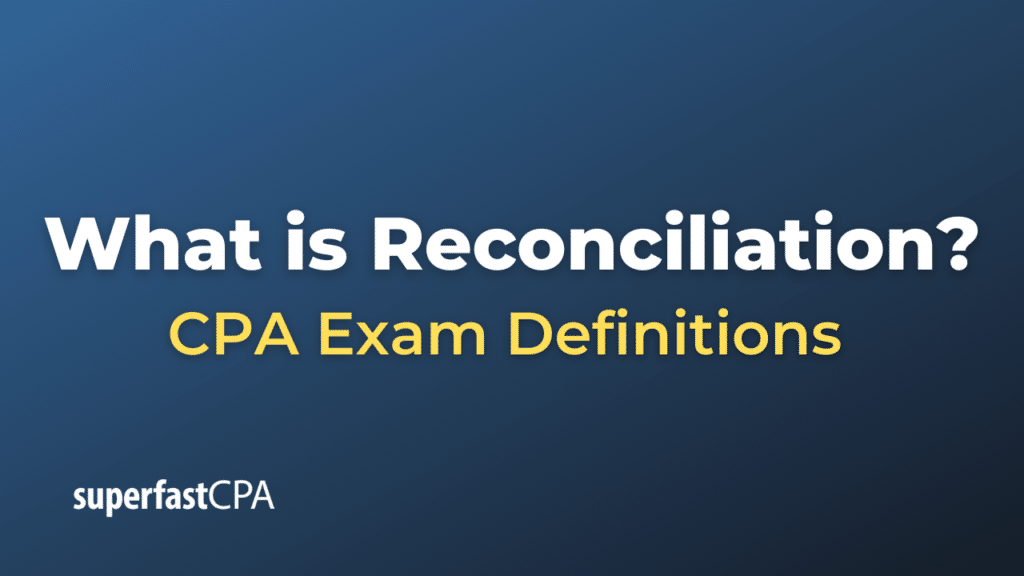Reconciliation
Reconciliation is the process of comparing two sets of records or data to ensure that they are consistent and in agreement with each other. It is a vital accounting procedure that is used to verify the accuracy and consistency of financial records. By identifying any discrepancies or differences between records, reconciliation helps in ensuring that financial statements are accurate and complete.
Reconciliation is commonly applied in several contexts:
- Bank Reconciliation: This is one of the most common types of reconciliation. It involves comparing a company’s internal records of cash transactions (as recorded in the general ledger) with the bank statement provided by the company’s bank. Differences can arise due to bank fees, interest earned, checks not yet cleared, or errors.
- Accounts Receivable Reconciliation : This involves matching outstanding invoices to payments received to ensure that all customer payments are accounted for and properly posted.
- Inventory Reconciliation: It involves comparing the physical count of inventory items to the recorded amounts in the accounting system.
- Inter-company Reconciliation: For businesses that have multiple departments or subsidiaries, this reconciliation ensures that transactions between these entities are consistent across each entity’s books.
- Balance Sheet Reconciliation: This involves verifying the integrity of all balance sheet accounts by reconciling them to supporting documentation.
- Credit Card Reconciliation : Businesses that accept credit card payments will reconcile the daily or monthly merchant statements against their internal sales records to ensure all transactions are correctly processed.
Example of Reconciliation
Let’s delve into a detailed example of a bank reconciliation, which is one of the most common types of reconciliations performed by businesses and individuals.
Imagine you’re the accountant for ABC Boutique. At the end of April, ABC Boutique’s cash ledger shows a balance of $10,000. However, the bank statement from the boutique’s bank shows a balance of $9,600. You need to reconcile these differences.
Steps for Reconciliation:
- Starting Point:
- ABC Boutique’s ledger balance: $10,000
- Bank statement balance: $9,600
- Identify Outstanding Checks: Upon review, you find that there are two checks, one for $200 and another for $150, which ABC Boutique issued in late April, but the recipients have not yet cashed. This means these checks haven’t cleared the bank yet.
- Total outstanding checks: $350
- Identify Deposits in Transit: You also find a sales deposit of $50 made by ABC Boutique on the last day of April. This deposit might not have been processed by the bank until the beginning of May, so it doesn’t appear on the April bank statement.
- Total deposits in transit: $50
- Identify Bank Fees or Interest: The bank statement shows a bank service charge of $50 and interest earned of $50. These have not been recorded in the boutique’s ledger yet.
- Bank charges: -$50
- Interest earned: +$50 (These two effectively cancel each other out)
- Perform the Reconciliation : To reconcile, adjust the ledger balance with any items the business didn’t know about (like the bank fees and interest). Then, adjust the bank statement balance for items the bank wasn’t aware of (like the outstanding checks and deposits in transit).
- Ledger balance: $10,000
- Minus bank charges: -$50
- Plus interest earned: +$50
- Adjusted Ledger balance: $10,000
- Bank statement balance: $9,600
- Plus deposits in transit: +$50
- Minus outstanding checks: -$350
- Adjusted Bank balance: $9,300
As you can see, there’s still a discrepancy of $700 between the adjusted ledger balance and the adjusted bank balance. This would indicate that there might be an error in the ledger or some other items not accounted for.
In a real-world scenario, the accountant would further investigate any discrepancies. Once all discrepancies are accounted for and the two balances match, the reconciliation is complete. Regular bank reconciliations ensure that cash records are accurate and any discrepancies, either due to errors or fraud, are detected promptly.













